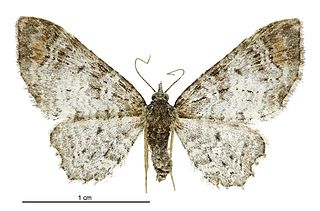
Pasiphila aristias is a species of moth in the family Geometridae. It was described by Edward Meyrick in 1897 and is endemic to New Zealand. This species is found in both the North and South Islands and inhabits subalpine and native forest. Adults are on the wing in December and January and are attracted to light.

Asaphodes albalineata is a species of moth in the family Geometridae. It is endemic to New Zealand and has been observed on Stewart Island / Rakiura. This species is similar in appearance to Asaphodes oraria but can be distinguished as it has an unusual pattern on the underside of its hindwings. It inhabits open hill tops and adults are on the wing in December.
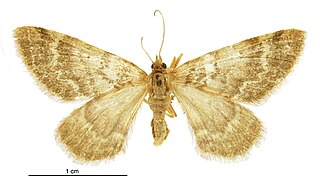
Asaphodes aphelias is a species of moth in the family Geometridae. It is endemic to New Zealand and has been observed in Fiordland. This species inhabits damp native scrub and has been observed in upland wetlands at altitudes of between 800 and 1100 m. Adults are on the wing in February but the female of this species is unusual as it has narrow fore and hind wings.
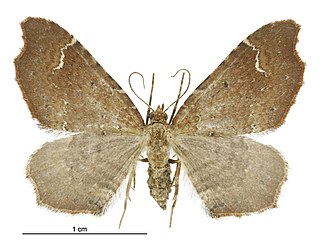
Asaphodes camelias is a species of moth in the family Geometridae. It is endemic to New Zealand, has been observed in both the North and South Islands and inhabits native forest. The adults of this species are on the wing from February to May and July to September.

Asaphodes chlamydota is a moth in the family Geometridae. It is endemic to New Zealand, and can be found in the lower part of the North Island and in the South Island. It inhabits native forest and shrublands. The larvae of this species feeds on native Clematis plants including Clematis afoliata. Adults are on the wing from November to April and are regarded as having intermedia flight powers.

Asaphodes chlorocapna is a species of moth in the family Geometridae. This species is endemic to New Zealand and can only be found in the Chatham Islands. The larvae of this species consume the leaves of Muehlenbeckia plants. Adults are on the wing in January. This species is classified as "At Risk, Relict'" by the Department of Conservation.

Asaphodes cinnabari is a species of moth in the family Geometridae. This species is endemic to New Zealand and can be found in Otago and Southland where it lives in alpine swampy habitat. Adults of this species are on the wing in November.

Asaphodes dionysias is a species of moth in the family Geometridae. This species is endemic to New Zealand and is only known from mountainous areas in Central Otago. It lives in open grassy mountainous habitat at altitudes up to 1750 m. It is also known to live in wetland habitat. The larvae of this species feed on native herbs. The adults of this species are on the wing in January and February. The adult female of the species has reduced wing size in comparison to the male.
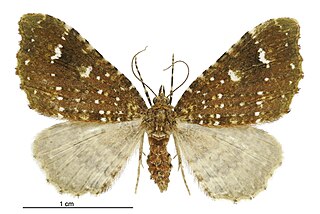
Asaphodes limonodes is a species of moth in the family Geometridae. It is endemic to New Zealand and is found in both the North and South Islands. This species inhabits damp native forest. Adults are on the wing from November until March.
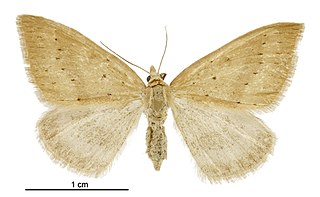
Asaphodes mnesichola is a species of moth in the family Geometridae. It is endemic to New Zealand and has been observed in the South Island. This species inhabits subalpine native scrub. Adults of this species are on the wing in January and February.

Asaphodes nephelias is a moth in the family Geometridae. It is endemic to New Zealand and has been observed in the South Island. The preferred habitat of this species is alpine tussock grasslands above native forest and in wetlands. The adults of this species are on the wing from January to March and are day flying. The female has brachypterous wings.
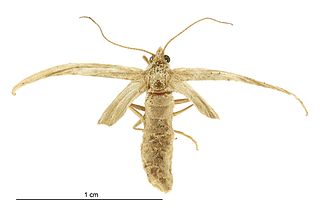
Asaphodes oraria is a species of moth in the family Geometridae. This species is endemic to New Zealand and has been observed in the southern South Island and on Stewart Island / Rakiura. The male is pale yellow coloured and the female has severely reduced wings and is flightless. The habitat of this species is tussock grasslands on coastal sand dunes and in the mountains at elevations of approximately 4,000 ft. The larvae have adapted to feeding on exotic lawn daisy species in the genus Bellis. The adults of this species are on the wing from November to April.
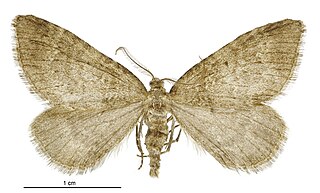
Asaphodes periphaea is a moth in the family Geometridae. It is endemic to New Zealand and has only been collected in the mountains near Lake Wakatipu in the South Island. The male is fuscous coloured sprinkled with whitish colouration. The female is brachypterous. The preferred habitat of this species are alpine bluffs as well as mountainous open country. This species is on the wing from January to March.

Asaphodes prasinias is a moth in the family Geometridae. It is endemic to New Zealand and has been found on both the North and South Islands. This species inhabits native forest including beech forest and subalpine scrub. The range of this species has reduced as this species is regarded as being locally extinct in the previously inhabited open non-forest habitats around Invercargill. Adults are on the wing from November to January.

Asaphodes prymnaea is a moth in the family Geometridae. It is endemic to New Zealand and can be found on the Mount Arthur tableland. It is common in limestone valleys. The female of the species is paler and has less distinctive markings than the male. Adults are on the wing in January and February.

Asaphodes recta is a moth in the family Geometridae. It is endemic to New Zealand and is found in the southern parts of the South Island. The preferred habitat of this species is open tussock grassland. The adults are on the wing in February and March. Larvae of this species have been reared on species in the genera Ranunculus and Bellis.
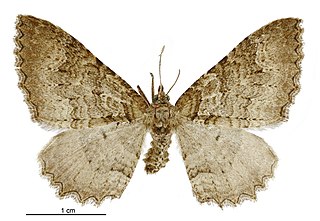
Austrocidaria cedrinodes is a species of moth of the family Geometridae. It was first described by Edward Meyrick in 1911. This species is endemic to New Zealand and has been observed in the North, South and Stewart Islands. Although widespread across the country A. cedrinodes is regarded as being a scarce species. It inhabits open native scrubland populated with species of Leptospermum, Dracophyllum as well as species in the genus Coprosma. This latter genus contains the larval host plants of A. cedrinodes. Adults are on the wing commonly from September until February and are nocturnal and attracted to light.
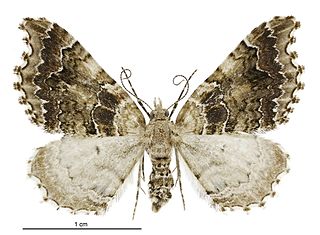
Helastia cymozeucta is a moth of the family Geometridae. It was first described by Edward Meyrick in 1913. This species is endemic to New Zealand and is found in both the North and the upper parts of the South Island. The adults of this species have been observed on the wing from November to January as well as in March.
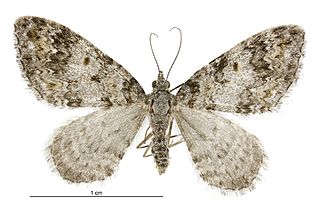
Helastia plumbea is a moth of the family Geometridae. This species is endemic to New Zealand and is found in both the North and South Islands. The species inhabits stream and river banks in montane to subalpine terrain. Adults are on the wing from October to April and are nocturnal and attracted to light. The life history of this species is, at 2024, poorly known but the larval host plants are likely mosses, herbs or possibly lichens.
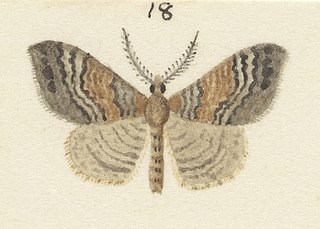
Homodotis amblyterma is a moth of the family Geometridae. This species was first described by Edward Meyrick in 1931. It is endemic to New Zealand and has been observed in Northland. Adults are on the wing in December.





















